| Vice President of the Federative Republic of Brazil | |
|---|---|
| Vice-Presidente da República Federativa do Brasil | |
 Coat of arms of Brazil Coat of arms of Brazil | |
 Vice presidential standard Vice presidential standard | |
 Incumbent IncumbentGeraldo Alckmin since January 1, 2023 | |
| Federal government of Brazil | |
| Style | Mr. Vice President (informal) The Most Excellent and His Excellency (formal) |
| Status | Second highest executive branch officer |
| Member of | Cabinet National Defense Council |
| Residence | Palácio do Jaburu |
| Seat | Brasília |
| Appointer | Direct popular vote (two rounds if necessary) |
| Term length | Four years, renewable once consecutively |
| Constituting instrument | Constitution of Brazil |
| Inaugural holder | Floriano Peixoto |
| Formation | February 26, 1891 (133 years ago) (1891-02-26) |
| Succession | First |
| Salary | R$ 39,293.32 per month |
| Website | www.gov.br/planalto |
| This article is part of a series on the |
| Politics of Brazil |
|---|
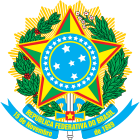 |
Executive
|
| Legislative |
Judiciary
|
| Law |
| Administrative divisions |
|
Elections
Recent elections |
Foreign relations
|
| Related topics |
The vice president of Brazil (Portuguese: Vice-Presidente do Brasil), officially the vice president of the Federative Republic of Brazil (Vice-Presidente da República Federativa do Brasil), or simply the vice president of the republic (Vice-Presidente da República) is the second-highest ranking government official in the executive branch of the Government of Brazil, preceded only by the president. The vice president's primary role is to replace the president in the event of their death, resignation, or impeachment conviction, and to temporarily take over the presidential powers and duties while the president is abroad, or otherwise temporarily unable to carry out their duties. The vice president is elected jointly with the president as their running mate.
The office has existed since the Proclamation of the Republic in 1889, although it was only officially instituted as of the 1891 Constitution. It has been in place throughout all of Brazil's republican history, save for the fifteen years of the Vargas Era when it was officially abolished.
Requirements
The requirements to run for the office of vice president are exactly those of the presidency itself. In addition to the ordinary requirements to run for political office in Brazil, under the terms of article 14 of the Constitution, a candidate for the vice presidency must be a natural-born citizen of Brazil (which under certain circumstances may include the offspring of one or two Brazilian parents living abroad) and be at least 35 years of age.
Election and tenure
The president and the vice president are elected on a single ticket for a four-year term and are inaugurated on January 1 of the year following that of the election. Both may be re-elected for a subsequent term.
Vice presidents succeeding a sitting president may be reelected for an additional term. However, the vice president is not eligible to run for a second full term, as under Brazilian law any partial term counts toward the limit of two consecutive terms. Due to the wording of the constitution's provisions on term limits, whenever the vice president serves as acting president when the president is either abroad or suspended from office as a result of impeachment, it counts as a partial term.
Workplace and official residence
The vice president works in an annex building of the Palácio do Planalto. The official residence of the vice president is the Palácio do Jaburu, inaugurated in 1977.
Ascension to the presidency
Since the Proclamation of the Republic in 1889, eight vice presidents have been called upon to replace former presidents: four due to death of the incumbent (Nilo Peçanha, Delfim Moreira, Café Filho, and José Sarney), two due to resignation (Floriano Peixoto and João Goulart), and two due to impeachment conviction (Itamar Franco and Michel Temer).
List of vice presidents
| No. | Portrait | Name (Birth–Death) |
Term | Party | Election | President | |
|---|---|---|---|---|---|---|---|
| 1 | 
|
Floriano Peixoto (1839–1895) |
February 26, 1891 – November 23, 1891 |
Unaffiliated | 1891 | Deodoro da Fonseca | |
| Office vacant (November 23, 1891 – November 15, 1894) | Floriano Peixoto | ||||||
| 2 | 
|
Manuel Vitorino (1853–1902) |
November 15, 1894 – November 15, 1898 |
PRF (Federal) |
1894 | Prudente de Morais | |
| 3 | 
|
Rosa e Silva (1857–1929) |
November 15, 1898 – November 15, 1902 |
Unaffiliated | 1898 | Campos Sales | |
| Office vacant (November 15, 1902 – June 17, 1903) | Rodrigues Alves | ||||||
| 4 | 
|
Afonso Pena (1847–1909) |
June 17, 1903 – November 15, 1906 |
PRM | 1903 | ||
| 5 | 
|
Nilo Peçanha (1867–1924) |
November 15, 1906 – June 14, 1909 |
PRF (Fluminense) |
1906 | Afonso Pena | |
| Office vacant (June 14, 1909 – November 15, 1910) | Nilo Peçanha | ||||||
| 6 | 
|
Venceslau Brás (1868–1966) |
November 15, 1910 – November 15, 1914 |
PRM | 1910 | Hermes da Fonseca | |
| 7 | 
|
Urbano Santos (1859–1922) |
November 15, 1914 – November 15, 1918 |
PRM | 1914 | Venceslau Brás | |
| 8 | 
|
Delfim Moreira (1868–1920) |
November 15, 1918 – January 16, 1919 |
PRM | 1918 | Rodrigues Alves | |
| Office vacant (January 16 – July 28, 1919) | Delfim Moreira | ||||||
| 8 | 
|
Delfim Moreira (1868–1920) |
July 28, 1919 – July 1, 1920 |
PRM | 1918 | Epitácio Pessoa | |
| Office vacant (July 1 – November 10, 1920) | |||||||
| 9 | 
|
Bueno de Paiva (1861–1928) |
November 10, 1920 – November 15, 1922 |
PRM | 1920 | ||
| 10 | 
|
Estácio Coimbra (1872–1937) |
November 15, 1922 – November 15, 1926 |
Unaffiliated | — | Artur Bernardes | |
| 11 | 
|
Melo Viana (1878–1954) |
November 15, 1926 – October 24, 1930 |
PRM | 1926 | Washington Luís | |
| Office vacant (October 24, 1930 – July 16, 1934) Office abolished (July 16, 1934 – September 19, 1946) |
Military junta of 1930 | ||||||
| Getúlio Vargas | |||||||
| José Linhares | |||||||
| Eurico Gaspar Dutra | |||||||
| 12 | 
|
Nereu Ramos (1888–1958) |
September 19, 1946 – January 31, 1951 |
PSD | 1946 | ||
| 13 | 
|
Café Filho (1899–1970) |
January 31, 1951 – August 24, 1954 |
PSP | 1950 | Getúlio Vargas | |
| Office vacant (August 24, 1954 – January 31, 1956) | Café Filho | ||||||
| Carlos Luz | |||||||
| Nereu Ramos | |||||||
| 14 | 
|
João Goulart (1919–1976) |
January 31, 1956 – August 25, 1961 |
PTB | 1955 1960 |
Juscelino Kubitschek | |
| Jânio Quadros | |||||||
| Office vacant (August 25, 1961 – April 15, 1964) | Ranieri Mazzilli | ||||||
| João Goulart | |||||||
| Ranieri Mazzilli | |||||||
| 15 | 
|
José Maria Alkmin (1901–1974) |
April 15, 1964 – March 15, 1967 |
PSD | 1964 | Castelo Branco | |
| ARENA | |||||||
| 16 | 
|
Pedro Aleixo (1901–1975) |
March 15, 1967 – August 31, 1969 |
ARENA | 1966 | Costa e Silva | |
| Office vacant (August 31 – October 30, 1969) | Military junta of 1969 | ||||||
| 17 | 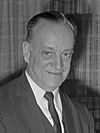
|
Augusto Rademaker (1905–1985) |
October 30, 1969 – March 15, 1974 |
ARENA | 1969 | Emílio Médici | |
| 18 | 
|
Adalberto Pereira dos Santos (1905–1984) |
March 15, 1974 – March 15, 1979 |
ARENA | 1974 | Ernesto Geisel | |
| 19 | 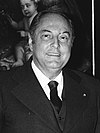
|
Aureliano Chaves (1929–2003) |
March 15, 1979 – March 15, 1985 |
ARENA | 1978 | João Figueiredo | |
| PDS | |||||||
| PFL | |||||||
| 20 | 
|
José Sarney (b. 1930) |
March 15, 1985 – April 21, 1985 |
PMDB | 1985 | Tancredo Neves (president-elect) | |
| Office vacant (April 21, 1985 – March 15, 1990) | José Sarney | ||||||
| 21 | 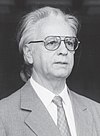
|
Itamar Franco (1929–2011) |
March 15, 1990 – December 29, 1992 |
PRN | 1990 | Fernando Collor | |
| PMDB | |||||||
| Office vacant (December 29, 1992 – January 1, 1995) | Itamar Franco | ||||||
| 22 | 
|
Marco Maciel (1940–2021) |
January 1, 1995 – January 1, 2003 |
PFL | 1994 1998 |
Fernando Henrique Cardoso | |
| 23 | 
|
José Alencar (1931–2011) |
January 1, 2003 – January 1, 2011 |
PL | 2002 2006 |
Lula da Silva | |
| PRB | |||||||
| 24 | 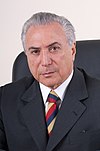
|
Michel Temer (b. 1940) |
January 1, 2011 – August 31, 2016 |
PMDB | 2010 2014 |
Dilma Rousseff | |
| Office vacant (August 31, 2016 – January 1, 2019) | Michel Temer | ||||||
| 25 | 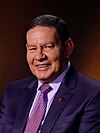
|
Hamilton Mourão (b. 1953) |
January 1, 2019 – January 1, 2023 |
PRTB | 2018 | Jair Bolsonaro | |
| Republicans | |||||||
| 26 | 
|
Geraldo Alckmin (b. 1952) |
January 1, 2023 – Incumbent |
PSB | 2022 | Lula da Silva | |
See also
Notes
- President Fernando Collor de Mello was impeached by the Chamber of Deputies, but resigned before being convicted in the Senate, resulting in Itamar Franco becoming President while the trial of Collor continued (eventually resulting in a conviction and his disqualification from public office for eight years).
- ^ Assumed the presidency following the resignation of the president.
- Acting president from November 10, 1896 to March 3, 1897. President Prudente de Morais was absent from his office due to health issues.
- Vice president-elect Silviano Brandão died before taking office, thus making the position vacant.
- ^ Elected to fill the vacancy.
- ^ Assumed the presidency following the death of the president.
- Became interim president, as vice president, between November 15, 1918 and January 16, 1919. When president-elect Rodrigues Alves died, he continued as interim president until July 28, 1919. The Constitution of the time stipulated that the vice president would only assume the presidency definitively if the term of the president was interrupted two years after his inauguration, that is, halfway through his term.
- Died in office.
- Replaced vice president-elect Urbano Santos, who had died before taking office.
- Estácio Coimbra was a member of the Barreiros Republican Party, a branch of the Federal Republican Party (PRF) founded in 1894 in Pernambuco. After the dissolution of the PRF in 1897, no record exists of Coimbra joining another political party.
- Deposed by the Revolution of 1930.
- The office of vice president was abolished by the 1934 Constitution, but restored by the 1946 Constitution, promulgated on September 18 of that year. The indirect election and inauguration of the new vice president took place the following day.
- Until the dissolution of the party on October 27, 1965.
- After Costa e Silva was removed from office for health issues, Pedro Aleixo was prevented from assuming the presidency by the military junta of 1969. Officially, his office was revoked on October 14 by the AI-16, signed by the military triumvirate.
- Until the dissolution of the party on December 20, 1979.
- Aureliano Chaves was the leader and one of the founders of the Liberal Front Party, a dissident group from the Social Democratic Party (PDS), after it chose Paulo Maluf as its candidate for the 1985 presidential election. Also, he was responsible for launching the party manifesto in December 1984, together with 11 former PDS members.
- Acting president until the death of president-elect Tancredo Neves, who became gravely ill the night before the inauguration.
- Assumed the presidency following the death of president-elect Tancredo Neves.
- Until May 1992.
- Until September 2005.
- Assumed the presidency following the impeachment of the president.
- Until March 2022.
References
- "Decreto nº 9.758, de 11 de abril de 2019". Diário Oficial da União (in Portuguese). No. 70–A. Impressa Nacional. 11 April 2019. p. 5. ISSN 1677-7042. Retrieved 4 February 2021.
- Zanatta, Pedro (1 January 2023). "Saiba quanto passa a ser o salário do presidente, vice, ministros e governadores". CNN Brasil (in Brazilian Portuguese). Retrieved 19 October 2023.
- "Urbano Santos da Costa Araújo". Instituto Histórico e Geográfico Brasileiro (in Portuguese). Retrieved 17 September 2023.
- "Vice-presidente Urbano Santos da Costa Araújo". Biblioteca da Presidência da República (in Portuguese). Archived from the original on 14 July 2014. Retrieved 17 September 2023.
- Moreira, Regina da Luz. "COIMBRA, Estácio" (PDF). FGV CPDOC (in Portuguese). Retrieved 19 September 2023.
- Setemy, Adrianna. "PARTIDO REPUBLICANO FEDERAL (PRF)" (PDF). FGV CPDOC (in Portuguese). Retrieved 19 September 2023.
- Sousa, Patrícia Campos de. "CHAVES, Aureliano". FGV CPDOC (in Portuguese). Retrieved 19 September 2023.
External links
- Vice-Presidency of Brazil Official Website
- Official vice presidential portrait
| Vice Presidents of South America | |
|---|---|
| Sovereign states | |